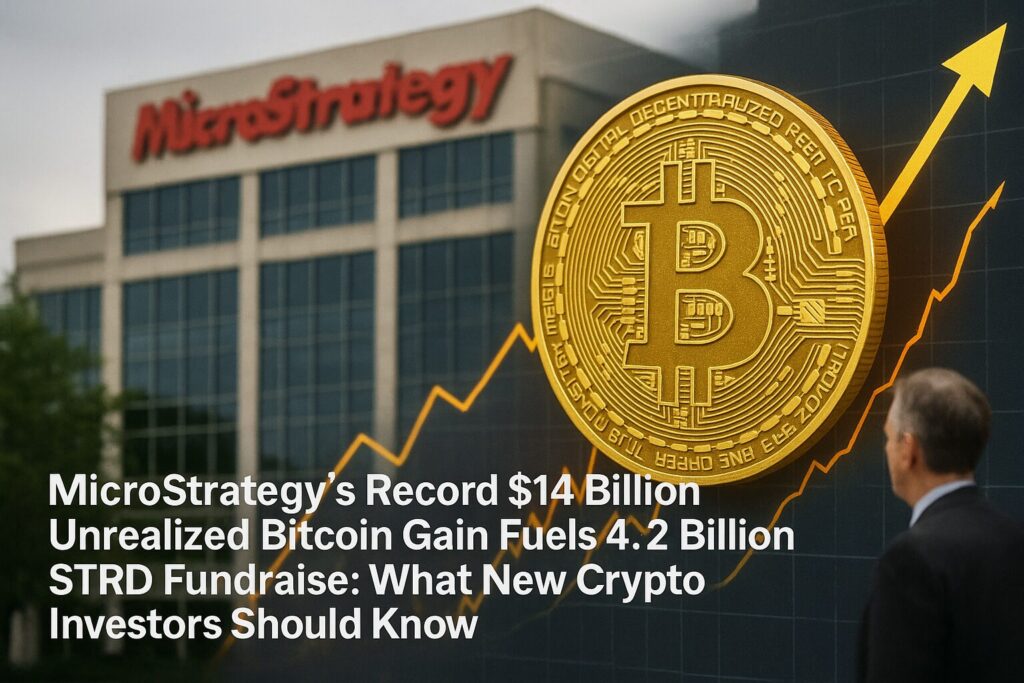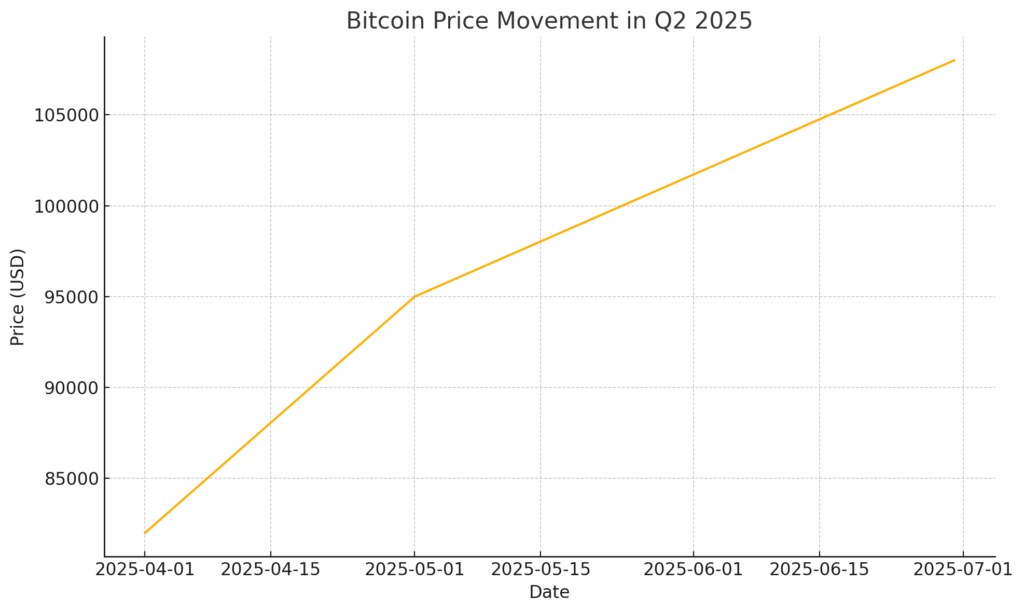
Main Points:
- Q2 2025 Unrealized Gain: MicroStrategy (MSTR) logged a $14.05 billion unrealized gain on ~500 k BTC as its price jumped from ~$82 000 to ~$108 000.
- STRD Preferred Stock Program: The company launched a 10 % Series A Perpetual Stride Preferred Stock (STRD), targeting up to $4.2 billion in proceeds for future BTC purchases and working capital.
- Market Impact: MSTR’s moves have driven institutional confidence in Bitcoin, but also raise concerns about potential sell‐pressure and overreliance on BTC for corporate value.
- Investor Takeaways: Understand the difference between unrealized gains and cash profits, weigh risks of concentrated crypto exposure, and consider diversification.
- Future Outlook: Continued ETF adoption, regulation, and macro factors will shape Bitcoin’s next leg; MSTR’s strategy may accelerate institutional inflows but comes with volatility.
1. Introduction
MicroStrategy, best known for its enterprise analytics software, has become the world’s largest corporate holder of Bitcoin. On July 7, 2025, the company reported an unprecedented second‐quarter unrealized gain of $14.05 billion on its Bitcoin holdings—a staggering figure that eclipses many Fortune 500 earnings. Alongside, MicroStrategy unveiled a $4.2 billion at‐the‐market (ATM) program via its new STRD preferred shares, positioning itself for even more BTC accumulation.
2. Who Is MicroStrategy?
2.1 Corporate Background
Founded in 1989, MicroStrategy provides business intelligence and analytics solutions. Under Executive Chairman Michael Saylor, however, the firm has pivoted to treat Bitcoin as a primary treasury reserve asset.
2.2 Bitcoin Accumulation Strategy
- Hodl Philosophy: MicroStrategy views Bitcoin as “digital gold,” aiming to hedge against fiat inflation.
- Scale of Holdings: As of June 30, 2025, it held about 597 325 BTC acquired at an average cost of $70 982 per coin.
- Corporate Treasury Use: Profits from BTC appreciation bolster book value, although gains remain unrealized until sales occur.
3. Q2 2025 Unrealized Gain Explained
3.1 Bitcoin Price Surge
Bitcoin climbed from roughly $82 000 on April 1 to $108 000 on June 30, a ~32 % rise driving MicroStrategy’s gain.
<Chart: Bitcoin Price Movement in Q2 2025>

3.2 Gain Calculation
- Holding: ~500 000 BTC
- Price Increase: $26 000 per coin
- Book Gain: 500 000 × $26 000 = $13 billion (adjusted to $14.05 billion per filings)
- Accounting Note: These are unrealized gains—paper profits that may fluctuate with market prices.
4. STRD Preferred Stock Program
4.1 What Is STRD?
The 10 % Series A Perpetual Stride Preferred Stock (STRD) carries no maturity and pays a fixed 10 % annual dividend. Shares trade under ticker STRD, recently hovering around $95.
4.2 Program Mechanics
- ATM Offering: Up to $4.2 billion of STRD shares can be sold gradually at market prices, minimizing price impact.
- Use of Proceeds: Primarily for additional Bitcoin purchases, working capital, and dividend obligations on existing preferred shares.
5. Impact on the Crypto Market
5.1 Positive Signals
- Institutional Entry: MSTR’s aggressive BTC accumulation encourages other corporates to consider crypto reserves.
- Price Support: Large, steady buys help underpin Bitcoin’s valuation, boosting confidence.
5.2 Cautionary Aspects
- Liquidity Risk: In a downturn, mass liquidations could exacerbate price slides.
- Concentration Risk: MSTR’s stock price now correlates heavily with BTC, increasing equity volatility.
6. Risks and Considerations for Investors
6.1 Understanding Unrealized vs. Realized Gains
Unrealized gains enrich balance sheets but only convert to cash when assets are sold. Investors should note tax implications and deferred expenses (MSTR reported a $4.04 billion deferred tax expense).
6.2 Key Investment Risks
| Risk Type | Description |
|---|---|
| Price Volatility | Rapid BTC swings greatly affect MSTR’s market value. |
| Leverage & Liquidity | ATM sales may not cover large cash needs in distressed markets. |
| Regulatory Changes | New crypto regulations could hinder Bitcoin’s appeal or liquidity. |
| Concentration | Heavy BTC focus reduces diversification—outsized exposure to one asset. |
7. Frequently Asked Questions
Q1. Is investing in MSTR equivalent to buying Bitcoin?
No. MSTR adds business operational risks and stock market dynamics; BTC investors gain direct asset exposure without corporate credit risk.
Q2. Why hasn’t MicroStrategy realized these gains?
The firm maintains a long‐term “HODL” stance, avoiding sales to maximize future appreciation potential.
Q3. Are the $14 billion gains actual cash profits?
No—they are paper gains. Market fluctuations will alter these numbers until coins are sold.
Q4. Can Japanese investors buy STRD?
Yes, via international brokers offering US‐listed preferred shares—note currency and cross‐border trading risks.
8. Outlook and Market Predictions
8.1 Bullish Catalysts
- ETF Proliferation: Greater BTC ETF adoption can drive institutional flows.
- Regulatory Clarity: Favorable rules may open banking corridors for crypto.
- Global Macro Uncertainty: Continued fiat debasement supports digital‐gold narratives.
8.2 Bearish Headwinds
- Rate Hikes: Higher U.S. interest rates can draw capital away from risk assets.
- Regulatory Clampdown: Stricter rules in major jurisdictions could restrict OTC liquidity.
9. Conclusion
MicroStrategy’s $14 billion unrealized gain in Q2 2025 underscores Bitcoin’s growing role as a corporate treasury asset. By launching a $4.2 billion STRD preferred stock program, the company cements its aggressive accumulation strategy. While this signals institutional validation for crypto, investors must weigh paper profits against real‐world risks—price swings, liquidity constraints, and regulatory shifts. For those seeking new crypto opportunities, MSTR offers a compelling case study in corporate Bitcoin adoption, but diversification and due diligence remain paramount.

